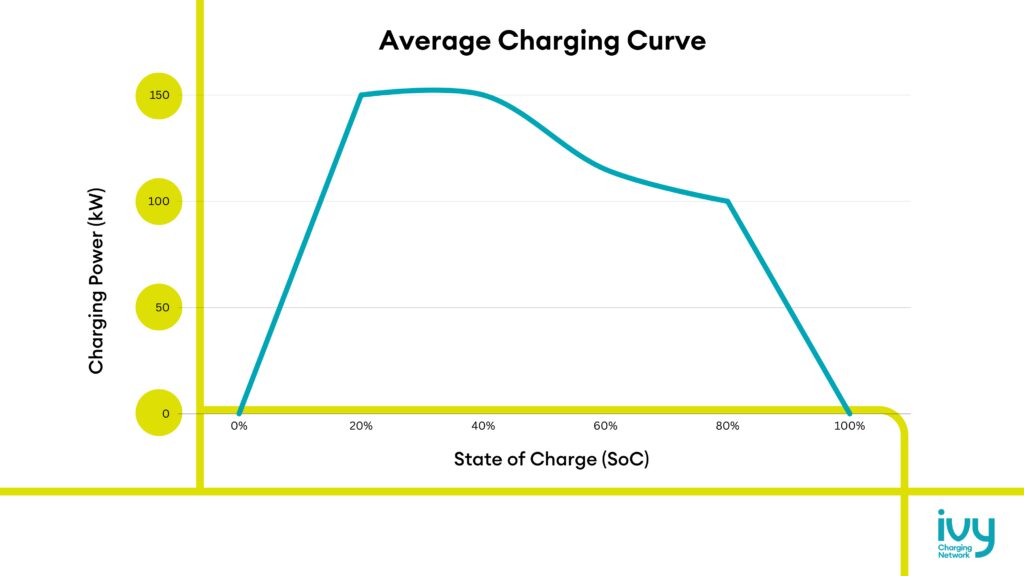Listen to this blog.
Everything you need to know about your electric vehicle’s charging speed.
Are you ready to explore the world of electric vehicles (EVs) and become a proud EV owner? One crucial aspect that can greatly affect your decision when choosing an EV model is its maximum charging capacity, which will determine your charging routine, whether at home or on the road. To save you some time from endless research, we’ve gathered valuable charging information and provided highlights of popular EVs in Ontario, including their maximum charging speeds.
Understanding EV charging.
Before choosing an electric vehicle based on its maximum charging speed, two important concepts are essential to grasp – charging curve and charging peak. Let’s explore these terms below:
Charging curve
A charging curve is a graphical representation of how an electric vehicle’s battery undergoes charging over time. It shows the maximum charge your vehicle can get throughout the charging process.
Most EV drivers notice that their EV charges most optimally when the battery level is between 10% and 80%. However, charging slows when the battery level goes above 80%. This is because it has reached the battery’s maximum charge rate (around 80%) and gradually reduces as it nears full capacity.

Peak charging
One common misconception is that electric vehicles can reach their maximum charging speed at any time. For example, if your EV’s maximum charging speed is 200 kW, it’s easy to assume that every time you plug into a 200-kW public fast charger (L3) it will deliver that full capacity each time. However, it doesn’t always work that way. For example, let’s say that your EV is at 10% and you plug into a 250-kW unit. Your vehicle may quickly reach its maximum charging speed (200 kW), but eventually, it will slow down as the battery charges. It’s the gradual increase and decrease that creates the charging curve.
Keep charging curves in mind when you can prepare for long-distance journeys. You can decide on the ideal charging stops based on the average charging session length and amenities available nearby. Thankfully, at highway service centres like ONroute in Ontario, you can charge your car at Ivy chargers while enjoying refreshments or taking a washroom break.
External factors that may affect your charging speed.
Additionally, several other external factors may affect your charging speed:
State of charge (SoC)
State of charge, or SoC, refers to how full your battery is. The higher the SoC, the slower the charging speed. This is due to charging slowing down when the battery approaches its maximum capacity to avoid overcharging and potentially causing battery damage. The recommended approach is to keep your EV’s battery between 20% and 80% and only charge beyond this when it is necessary.
Battery temperature
Charging speed can also be affected by extreme temperatures limiting charging efficiency and sometimes even causing damage to your battery. During hot summer months, park your EV in a shady area or in a garage to help keep the battery cool. During the winter, it is best to charge right away while your EV is warm or use a pre-conditioning tool on your EV’s app to warm up your vehicle before charging.
Other electrical loads
If you’re using electrical loads in your EV while charging such as air conditioning, heating or entertainment systems, some of your charging power may be diverted to power these loads which can slow down your charging speed.
Electric vehicle models and their maximum charging speeds.
One charging speed doesn’t fit all! Every auto manufacturer has different specs for their EV battery capacity so it’s important to find out what applies to your vehicle. We’ve compiled a list below of popular EVs in Ontario and their maximum charging speeds. It is always vital to consult and follow your vehicle’s manufacturer guidelines for charging recommendations specific to your electric vehicle.

Ontario’s public charging network.
Now that you’ve powered up your charging knowledge, you should feel more equipped to hit the road for a long drive. Before you hit the road, access some great tools to plan your route and see real-time charger status. Download PlugShare to see all chargers available along your route. You can also download the handy Ivy Charging Network 2.0 app to find available Ivy L3 and L2 chargers, check their status, pay for your session and order an RFID card so you can charge into adventure.
Join our electric community.
Be the first to hear about Ivy tips, promotions, and network updates.






